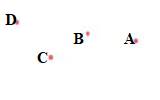
Concept explainers
The different ways in which a diagram can be labeled.
Answer to Problem 13PSC
The different ways in which a diagram can be labeled are ABCD , ABDC , ADBC , ADCB ,ACBD , ACDB , DCBA , CDBA , BCDA ,CBDA , DBCA , BDCA ,DCAB , CDAB , DBAC , BDAC, BCAD , CBAD.
Explanation of Solution
Given information:
4 points are given in a plane.
Concept used:
Calculation:
For A to be collinear with two other points, A can be at 3 positions first , third and fourth.
and remaining 3 letter can be arrange in 3 positions in
ABCD , ABDC , ADBC , ADCB ,ACBD , ACDB , DCBA , CDBA , BCDA ,CBDA , DBCA , BDCA ,DCAB , CDAB , DBAC , BDAC, BCAD , CBAD.
Conclusion:
Hence with given condition the diagram can be labeled in 18 different ways -
Few of these labeling are −









Chapter 1 Solutions
Geometry For Enjoyment And Challenge
Additional Math Textbook Solutions
Statistical Reasoning for Everyday Life (5th Edition)
College Algebra in Context with Applications for the Managerial, Life, and Social Sciences (5th Edition)
A First Course in Probability (10th Edition)
Calculus, Single Variable: Early Transcendentals (3rd Edition)
A Problem Solving Approach to Mathematics for Elementary School Teachers (12th Edition)
Single Variable Calculus: Early Transcendentals (2nd Edition) - Standalone book
 Elementary Geometry For College Students, 7eGeometryISBN:9781337614085Author:Alexander, Daniel C.; Koeberlein, Geralyn M.Publisher:Cengage,
Elementary Geometry For College Students, 7eGeometryISBN:9781337614085Author:Alexander, Daniel C.; Koeberlein, Geralyn M.Publisher:Cengage, Elementary Geometry for College StudentsGeometryISBN:9781285195698Author:Daniel C. Alexander, Geralyn M. KoeberleinPublisher:Cengage Learning
Elementary Geometry for College StudentsGeometryISBN:9781285195698Author:Daniel C. Alexander, Geralyn M. KoeberleinPublisher:Cengage Learning

